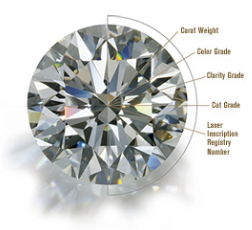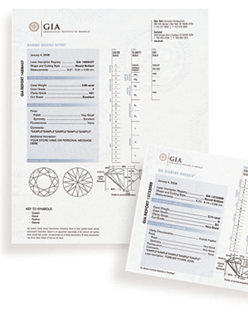Buying a diamond can be a significant purchase both emotionally and financially, but it doesn’t have to be intimidating. This GIA Diamond Buying Guide can help you determine what is the best quality diamond for you. Here are four basic steps to ensure that the journey to find your perfect diamond is as pleasurable as admiring the diamond you finally select.
First
 Choose a jeweler as you would a doctor, lawyer or other trusted advisor. Your jeweler should be armed with expert training, open to questions and able to provide answers in clear, simple language. One measure of a jeweler’s knowledge is whether he or she is professionally trained. Preferably, his or her training comes from a highly-recognized and internationally accredited program, such as GIA’s Graduate Gemologist (G.G) or Accredited Jewelry Professional (A.J.P.) diploma programs. An educated jeweler will explain the 4Cs of diamond quality to you as well as be able to demonstrate the differences between apparently similar gems. They will show what is the best quality diamond for you by comparing a number of diamonds that fall in your budget.
Choose a jeweler as you would a doctor, lawyer or other trusted advisor. Your jeweler should be armed with expert training, open to questions and able to provide answers in clear, simple language. One measure of a jeweler’s knowledge is whether he or she is professionally trained. Preferably, his or her training comes from a highly-recognized and internationally accredited program, such as GIA’s Graduate Gemologist (G.G) or Accredited Jewelry Professional (A.J.P.) diploma programs. An educated jeweler will explain the 4Cs of diamond quality to you as well as be able to demonstrate the differences between apparently similar gems. They will show what is the best quality diamond for you by comparing a number of diamonds that fall in your budget.
Second
Familiarize yourself with the 4Cs of diamond quality in order to understand a diamond’s value and price.
 Color − in most diamonds, the term actually refers to the absence of color. The less color in the diamond, the more desirable and valuable it is.
Color − in most diamonds, the term actually refers to the absence of color. The less color in the diamond, the more desirable and valuable it is.
Clarity − measures the number, size and placement of internal ‘inclusions’ and external ‘blemishes.’
Cut − does not refer to a diamond’s shape, but to the proportion and arrangement of its facets and the quality of workmanship. The amount of brilliance, sparkle and fire in a diamond is determined by cut.
Carat − refers to a diamond’s weight. Generally speaking, the higher the carat weight, the more expensive the stone.
We will explore more about the 4Cs here tomorrow so you are prepared to ask important questions.
Third
 Ask for a diamond grading report from an unbiased, scientific source like GIA. The differences in diamonds can be so subtle, even a trained jeweler can’t recognize them without lab verification. Insist that any diamond you buy come with verification of its quality.
Ask for a diamond grading report from an unbiased, scientific source like GIA. The differences in diamonds can be so subtle, even a trained jeweler can’t recognize them without lab verification. Insist that any diamond you buy come with verification of its quality.
Fourth
Protect your purchase by having your diamond appraised and insured. Appraisers and insurers rely on diamond grading reports (another good reason to ask for a grading report) to accurately evaluate the value of gems. There are several appraisal associations to assist you with finding one in your area. As an additional measure, consider having your diamond laser-inscribed with its GIA report number, to provide verification if it is ever lost or stolen.
We hope that these important steps will help you determine what is the best quality diamond you can find for the appropriate budget. Explore Part Two of the GIA Diamond Buying Guide where we focus on important details you should know about the 4Cs of diamond cut, color, clarity and carat weight.
Custom Field: Array